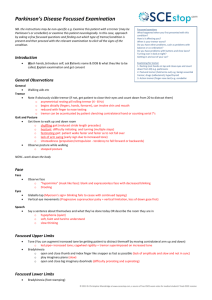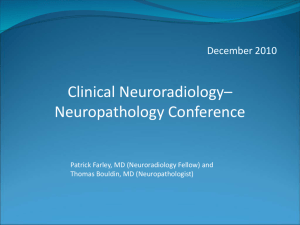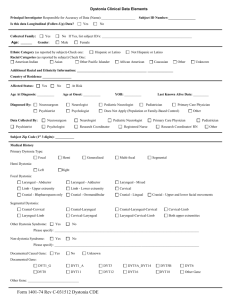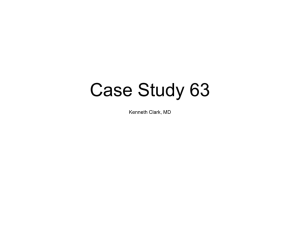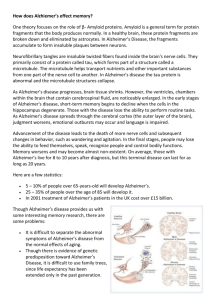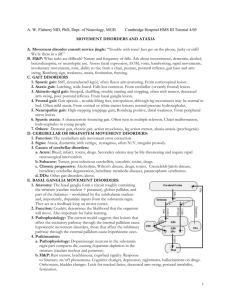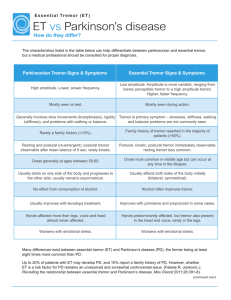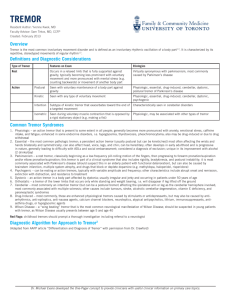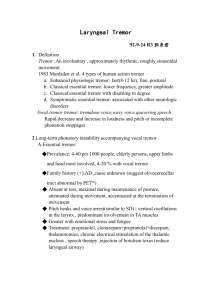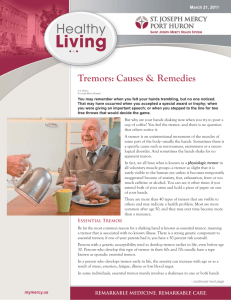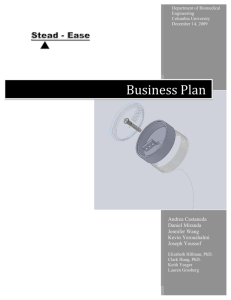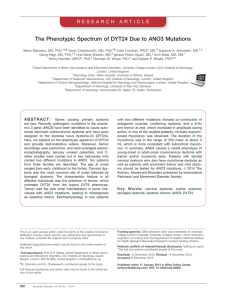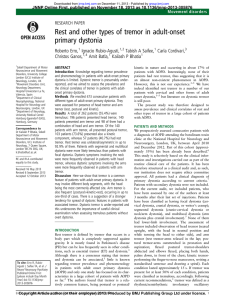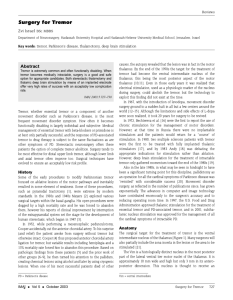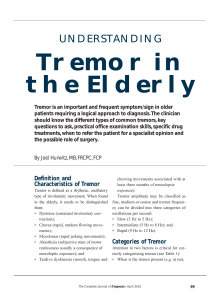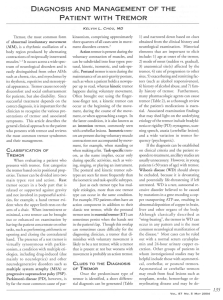Neurology_2008
advertisement
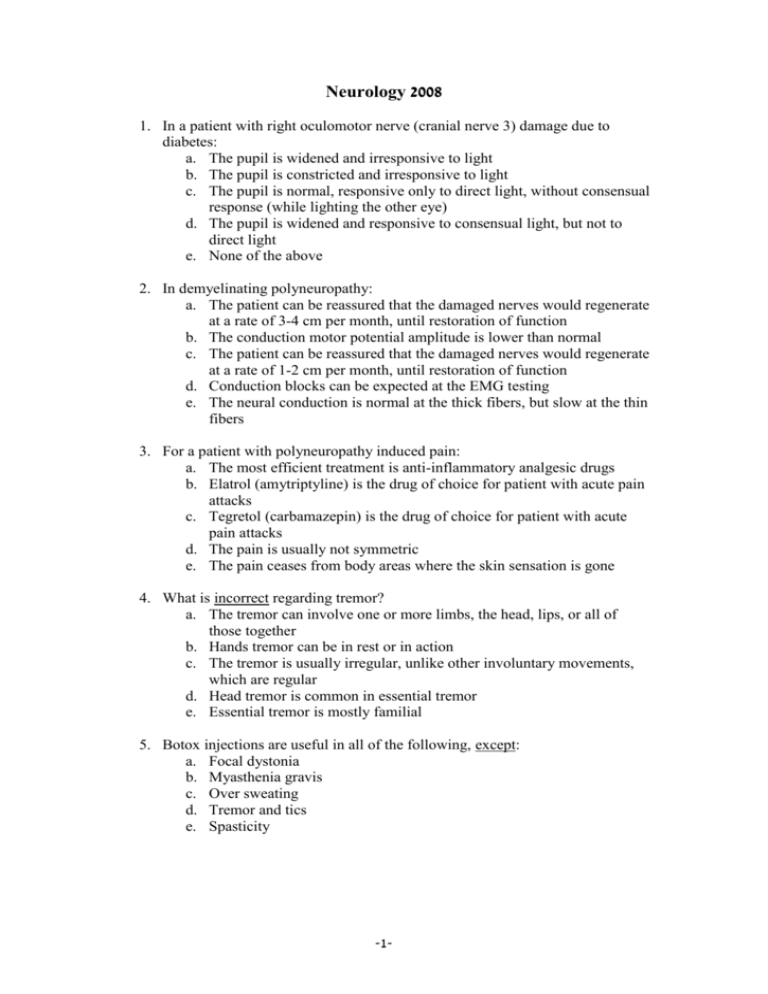
Neurology 2008 1. In a patient with right oculomotor nerve (cranial nerve 3) damage due to diabetes: a. The pupil is widened and irresponsive to light b. The pupil is constricted and irresponsive to light c. The pupil is normal, responsive only to direct light, without consensual response (while lighting the other eye) d. The pupil is widened and responsive to consensual light, but not to direct light e. None of the above 2. In demyelinating polyneuropathy: a. The patient can be reassured that the damaged nerves would regenerate at a rate of 3-4 cm per month, until restoration of function b. The conduction motor potential amplitude is lower than normal c. The patient can be reassured that the damaged nerves would regenerate at a rate of 1-2 cm per month, until restoration of function d. Conduction blocks can be expected at the EMG testing e. The neural conduction is normal at the thick fibers, but slow at the thin fibers 3. For a patient with polyneuropathy induced pain: a. The most efficient treatment is anti-inflammatory analgesic drugs b. Elatrol (amytriptyline) is the drug of choice for patient with acute pain attacks c. Tegretol (carbamazepin) is the drug of choice for patient with acute pain attacks d. The pain is usually not symmetric e. The pain ceases from body areas where the skin sensation is gone 4. What is incorrect regarding tremor? a. The tremor can involve one or more limbs, the head, lips, or all of those together b. Hands tremor can be in rest or in action c. The tremor is usually irregular, unlike other involuntary movements, which are regular d. Head tremor is common in essential tremor e. Essential tremor is mostly familial 5. Botox injections are useful in all of the following, except: a. Focal dystonia b. Myasthenia gravis c. Over sweating d. Tremor and tics e. Spasticity -1- 6. Which of the following is correct regarding cervical dystonia? a. This is a focal dystonia that has poor reaction to botox treatment b. This is a facial dystonia that causes involuntary mouth closure c. This is a segmental dystonia involving the head, neck and chest d. It disappears during sleep e. The most common reason for this dystonia is trauma 7. All of the following are symptoms of Parkinson disease, except: a. Lack of coordination b. Rest tremor c. Slowness d. Muscle rigidity e. Mask face 8. During treatment with levodopa, motor side effects are possible. In which of the following are these side effects more common? a. In elderly patients, without relation to the duration of the disease b. In patients with longer duration of the disease c. Motor side effects are not related to the dosage of the drug d. In patients who are co-treated with comtan e. In women 9. A 23-yo woman attends to the ER with an extremely severe headache that has started 3-4 hours ago and is accompanied by nausea and sensitivity to light and noise. This is the third attack of the same kind during the last 6 months. Her neurological examination is normal. The symptoms are most likely to represent: a. Acute sinusitis b. Subarachnoid hemorrhage c. Trigeminal neuralgia d. Migraine attack e. Intracranial hemorrhage 10. Which of the following statements is correct regarding neuropathic pain? a. Can be caused by damage all along the somatosensory nervous system b. Is commonly characterized as "burning" pain or as ""currents" c. At examination, sensory lack can be found at the painful area d. Is regarded as pathological pain e. All of the above are correct 11. Which of the following drugs is used to prevent migraine attacks? a. Beta blockers b. Triptans c. Dopaminergic agonists d. Tegretol e. ACE inhibitors -2- 12. What is the best way to estimate pain intensity? a. Watching the patient and his/her behavior b. According to pain scale estimation c. According to autonomic signs - blood pressure, pulse, respiratory rate d. There is no use in pain estimation as it is subjective anyway e. According to patient's complaints 13. A 54-yo man has collapsed during a raging meeting. After several minutes he has recovered and started to speak unceasingly. He couldn't be stopped from his speaking, nor did he react to questions or statements addressed to him. Although most of his words were comprehensive, some words weren't. At examination: cranial nerves, tonus, muscle strength, tendon reflexes, cerebellum exams and gait are normal. The doctor has had the impression that the patient has suffered a CVA that has presented as: a. Broca aphasia b. Conduction aphasia c. Wernicke aphasia d. Trans-cortical aphasia e. Global aphasia 14. What is correct regarding Alzheimer's disease? a. This is the second most common dementia b. 30% of people above the age of 70 suffer from it c. HIV positive Alzheimer patients have better reaction to acetyl choline esterase inhibitors d. The treatment is with acetyl choline esterase inhibitors e. The primary presentation of the disease is extra-pyramidal 15. A patient has been brought to the ER after he's been found unconscious on the pavement. All of the following would rise the suspicion of epileptic attack, except: a. Signs of tongue biting b. Unequal pupils c. Right shoulder dislocation d. Pants wet from urine e. The patient wakes up in the ambulance on the way to the hospital, but is still confused upon arriving to the ER 16. A patient has been brought to the ER following loss of consciousness and convulsions of four limbs. During the evaluation, head CT was performed, showing a meningioma at the left frontal area. What is the type of the epileptic attack? a. General tonic-clonic b. Absence c. Myoclonus d. Complex focal e. Simple focal f. None of the above -3- 17. A 23-yo woman attends the ER following a convulsions attack that included loss of consciousness. She reveals that she had 3 similar attacks during the last year, including moments of 10-20 seconds of absence. What is the best treatment of this patient? a. Carbamazepine b. Valproic acid c. Benzodiazepines d. No treatment is needed 18. A 56-yo man has been operated due to a big tumor at the frontal lobe. At pathological examination - atypia, mitoses, necrosis and blood vessels proliferation in the tumor. GFAP staining was positive. What is the diagnosis? a. Astrocytoma grade 2 b. Glioblastoma multiforme c. Medulloblastoma d. Malignant meningioma e. Carcinoma metastasis 19. What is correct regarding Lewi bodies dementia? a. This is a very rare cause of dementia b. Lewi bodies are found in astrocytes (glia cells) c. The substantia nigra is usually not involved d. Alzheimer's disease changes can be found in 10% of the cases e. Lewi bodies are positively stained for ubiquitin 20. All of the following are correct regarding multiple sclerosis, except: a. The lymphocytes that begin the demyelination process are CD4 T lymphocytes b. Most of the plaques are in the cortex c. Marked infiltration of lymphocytes and macrophages can be seen in active plaques d. Shadow plaques present low quantity of myelin due to incomplete remyelinization or demyelinization e. Plaque with reactive gliosis sometimes resembles low grade astrocytosis 21. All of the following are correct regarding cerebral hemorrhage, except: a. Berry aneurysm is the most common cause of subarachnoid hemorrhage b. The most common location of hypertensive hemorrhage is the putamen c. Cerebral vasculitis is the most common cause of cerebral hemorrhage d. An open brain surgery can be a risk factor e. Most of the patients are of age 60 and above -4- 22. What is correct regarding PML? a. Is caused by HIV b. The main damage is at oligodendroglia c. Strong staining by luxol fast blue is a characteristic sign of the damaged area d. Bizzare giant neurons can be seen around the damaged area e. Most of the lesions are located at the area of the cortex 23. All of the following are correct regarding Alzheimer's disease, except: a. Brain weight can be normal b. Temporal and frontal lobe atrophy can be seen c. The changes are equally distributed at the different areas of the brain d. The cortex seems thinner than normal e. In the aging brain, microscopic changes, similar to Alzheimer's disease, can be seen 24. All of the following are correct regarding slide number 5 (meningioma), except: a. Multiple mitoses in this tumor suggest more aggressive behavior b. Tends to recur, even when benign c. Invasion into the brain increases the recurrence chances d. More common in women e. The most common chromosomal change is related to chromosome 21 25. All of the following are signs of Alzheimer's disease, except: a. Amyloid (senile) plaques b. Neurofibrillary tangles c. Granulovascular degeneration d. Intranuclear inclusions e. Amyloid angiopathy 26. What is correct regarding Alzheimer's disease? a. A-peptide is the product of phosphatase activity b. Tau is a pathological protein that is not found in a normal cell c. The APP molecule has an intracellular, extra cellular, and transmembrane parts d. Amyloid plaques do not include axons e. Number of amyloid plaques in the brain shows the best correlation with the level of the dementia 27. A 56-yo woman, suffering from hypertension, is admitted to the ER in comatose state that has developed quickly at her work. CT shows an extended subarachnoid hemorrhage at the base of the brain. What is the most reasonable cause of this state? a. Acute bacterial meningitis b. Tuberculous meningitis c. Amyloid angiopathy d. Ruptured aneurysm e. Vasculitis -5- 28. What is correct regarding CMV encephalitis? a. Is common among 5-10-yo children b. Causes hemorrhagic necrosis around cerebral ventricles only in immunosuppressed patients c. Granulomas with giant cells are seen in the brain d. Does not involve the spinal cord and the roots e. The diagnosis is usually possible only with PCR 29. The main cause of global cerebral ischemia is: a. Thrombosis of middle cerebral artery b. Rupture of aneurysm c. Brain contusion d. Severe hypotensive episode e. Meningeal fibrosis Possible answers: 1. e 2. d 3. c 4. c 5. b 6. question cancelled 7. a 8. b 9. d 10. e 11. a 12. b 13. c 14. question cancelled 15. b 16. f 17. 18. b 19. e 20. b 21. c 22. b 23. c 24. e 25. d 26. c 27. d 28. 29. d -6-






